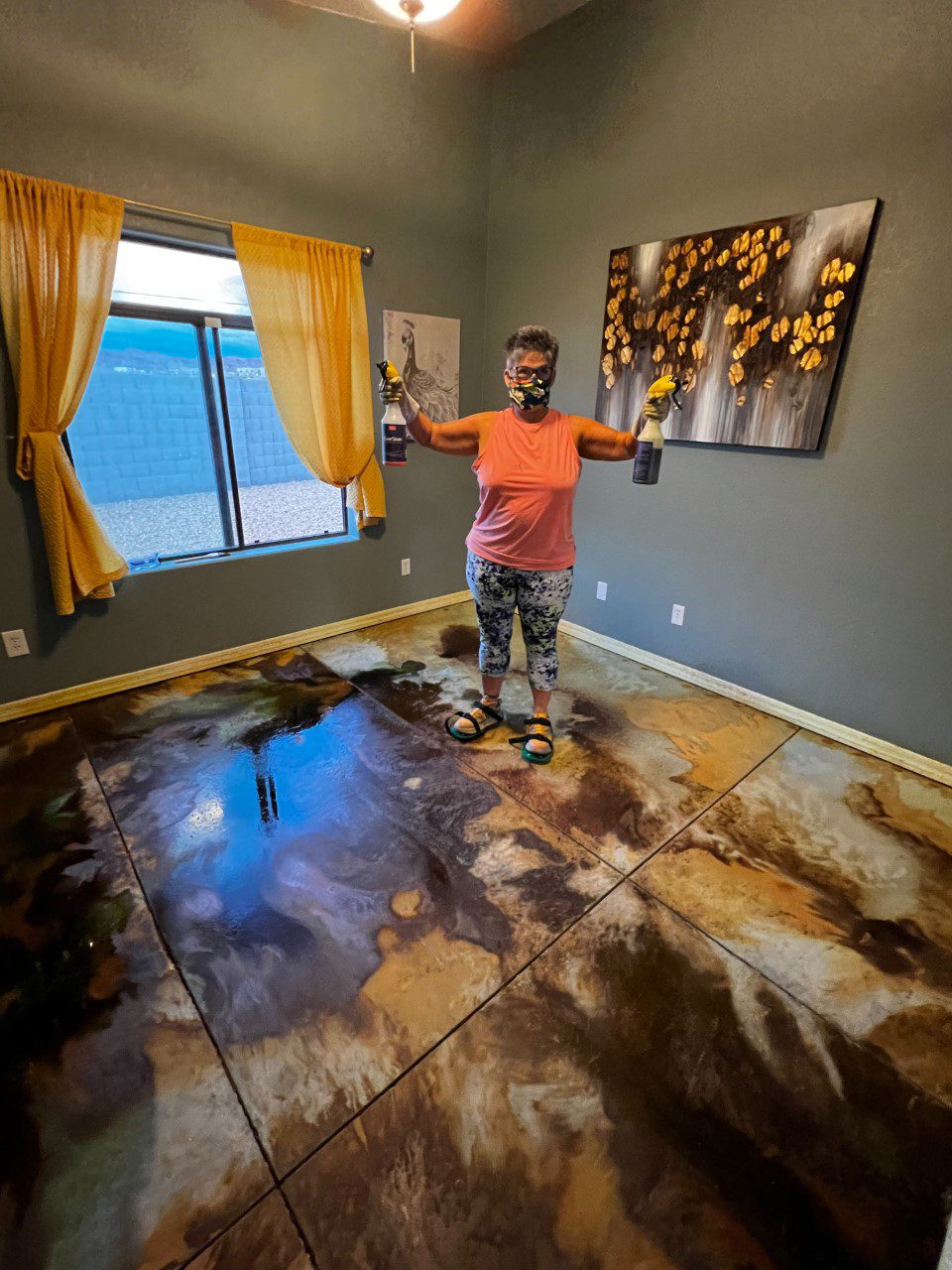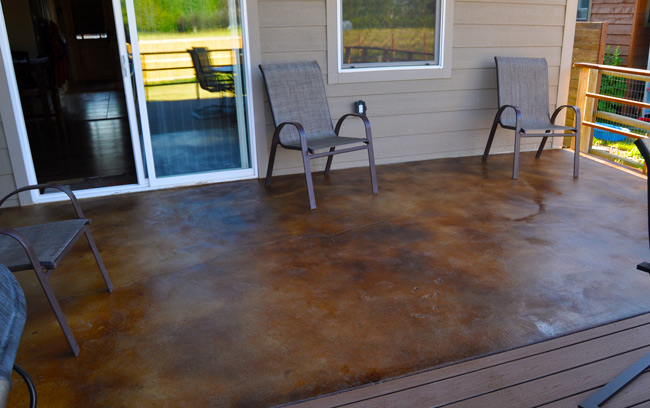Step-by-step guide for maintaining stained concrete floors
Everything About Stained Concrete: A Comprehensive Overview to Its Advantages and Applications
Stained concrete has emerged as a prominent selection for both property and business spaces. Its capability to incorporate visual allure with usefulness makes it an interesting choice. Different staining strategies provide a variety of colors and finishes, enabling modification. Nonetheless, the advantages expand past appearance. Understanding its applications and upkeep demands is necessary for any person considering this functional product. The subtleties of stained concrete invite further exploration.
What Is Stained Concrete?

Discoloration can be used to numerous surfaces, consisting of floorings, driveways, and patio areas, making it a versatile option for both interior and exterior spaces. The treatment can attain a variety of looks, from natural tones to strong, contemporary designs. Unlike paint, stained concrete maintains its look gradually, as it ends up being an important component of the concrete itself. Overall, stained concrete works as a reliable technique for changing average concrete right into aesthetically striking surface areas.
Advantages of Stained Concrete
Stained concrete deals substantial advantages, especially in aesthetic appeal and durability - stained concrete. Its lively colors and unique patterns enhance the aesthetic appeal of any space, making it a popular choice for both household and industrial applications. In addition, the long life of stained concrete guarantees that it remains a practical financial investment gradually, withstanding wear and tear
Visual Appeal
Among one of the most compelling benefits of using stained concrete is its impressive visual charm. Stained concrete deals an unique and functional look that can enhance different layout styles, from modern to rustic. The mixture of vibrant shades and intricate patterns enables house owners and designers to develop customized surface areas that can enhance the overall atmosphere of a room. Unlike typical flooring options, stained concrete can resemble the appearance of all-natural rock or polished marble, supplying a high end look without the connected prices. Furthermore, the shiny finish alternatives can mirror light, additional lightening up interiors. This versatility makes stained concrete a favored selection for both residential and industrial applications, where aesthetic influence is critical.
Sturdiness and Long life
The impressive aesthetic high qualities of stained concrete are enhanced by its impressive sturdiness and longevity - stained concrete company. Stained concrete surface areas are immune to wear and tear, making them suitable for high-traffic locations both indoors and outdoors. Their durable nature suggests they can endure extreme weather condition problems, including extreme temperature levels, rain, and UV direct exposure, without significant degradation. In addition, stained concrete requires minimal upkeep compared to other flooring options, as it does not need frequent sealing or refinishing. This longevity not only lowers substitute expenses however additionally contributes to a sustainable building approach. Overall, stained concrete supplies an enduring solution that integrates visual appeal with sensible benefits, ensuring its value in time
Various Kinds of Staining Methods
Different discoloration techniques can significantly impact the visual high qualities of concrete surface areas. The three key approaches include acid staining, which reacts chemically with the concrete, water-based staining, which provides a wider range of shades, and overlay discoloration choices that give a fresh surface. Each technique has distinct attributes and applications that provide to various layout preferences and task demands.
Acid Staining Approach
How can home owners transform simple concrete surfaces right into visually striking attributes? One efficient method is acid staining, a preferred strategy that boosts the all-natural appeal of concrete. This process includes applying a remedy of water, hydrochloric acid, and metallic salts to the concrete surface area. As the acid reacts with the lime existing in the concrete, it creates abundant, variegated shades that look like marble or rock. Acid staining is understood for its toughness and resistance to fading, making it a lasting option for both indoor and outdoor applications. It is essential to keep in mind that the results can differ based on the original concrete color and structure. Correct application and sealing are crucial for attaining the wanted visual and durability
Water-Based Staining Method
A preferred choice to acid discoloration, the water-based staining method provides house owners a versatile way to enhance concrete surface areas. This method uses water-soluble dyes and pigments, permitting for a large range of colors and surfaces. Unlike acid spots, water-based stains can be applied to unsealed concrete and offer a simpler cleaning procedure. The outcomes can attain a much more consistent look and can be layered to produce special impacts. Additionally, water-based spots are normally less harmful and send out fewer volatile natural substances (VOCs), making them a lot more eco friendly. Homeowners may appreciate the ability to personalize their concrete surface areas with various shades, enabling for creative expression while preserving toughness and long life in their flooring choices.
Overlay Staining Options
Numerous overlay staining alternatives exist for home owners seeking to invigorate their concrete surface areas. One popular choice is acid discoloration, which reacts chemically with the concrete to generate rich, variegated colors. An additional alternative is water-based discoloration, supplying a more comprehensive color scheme and simpler application. Additionally, concrete overlays can be combined with patterns for elaborate styles, enhancing visual appeals. For an extra distinctive finish, house owners may take into consideration using stamped overlays that simulate natural products like stone or tile. Each method supplies one-of-a-kind benefits, from longevity to customization, enabling for a tailored touch. Inevitably, the choice of overlay staining depends upon the preferred appearance and the problem of the existing concrete, guaranteeing a revitalized and appealing surface area.
Applications of Stained Concrete
Stained concrete deals a flexible option for numerous applications, boosting both aesthetic appeal and capability. This product is generally utilized in domestic, commercial, and industrial settings, making it a popular selection amongst engineers and developers. In homes, stained concrete can act as trendy flooring or outdoor patios, offering an advanced appearance while staying long lasting.
In business rooms, such as find more retailers and restaurants, stained concrete adds to a modern-day ambiance and can withstand heavy foot website traffic. Additionally, stained concrete is significantly utilized in public rooms like parks and walkways, where its capacity to mimic natural rock or other products includes visual interest.
Additionally, stained concrete is optimal for pool decks and driveways, using a slip-resistant surface area that is simple to keep. On the whole, the adaptability of stained concrete makes it suitable for many environments, satisfying diverse preferences and demands.
Maintenance and Take Care Of Stained Concrete
Appropriate maintenance ensures the durability and appeal of stained concrete surface areas. Normal cleansing is important; utilizing a moderate cleaning agent and water with a soft-bristle brush assists get rid of dust and gunk without harming the finish. It is suggested to avoid rough chemicals that can strip away the discolor or sealer.
Securing stained concrete is crucial for defense versus wetness, discolorations, and put on. A top quality sealer should be reapplied every one to three years, relying on the web traffic and direct exposure the surface area sustains. Furthermore, resolving spills quickly will prevent staining and discoloration.

Expense Factors To Consider for Stained Concrete Projects
When preparing a stained concrete job, budget considerations play a crucial duty in identifying the general price. The expenses connected with stained concrete can differ significantly based upon numerous aspects. First, the dimension of the area to be stained directly influences material and labor costs. Bigger rooms will normally require more sources. Second, the kind of tarnish picked-- acid-based or water-based-- can influence rates, with acid stains frequently being a lot more expensive. In addition, the complexity of the design, including patterns or multiple colors, can increase labor expenses. Preparation job, such as cleansing and grinding the concrete surface area, includes in the preliminary expenditures too. The choice between DIY installation and hiring a professional contractor will further impact the budget plan. Recognizing these aspects makes it possible for property owners to make enlightened economic decisions concerning their stained concrete projects, guaranteeing they accomplish the preferred visual within their financial methods.
Tips for Selecting the Right Stained Concrete for Your Space
Choosing the ideal stained concrete for a specific room involves mindful consideration of different variables beyond simply budget plan. First, one ought to evaluate the desired use of the area. High-traffic areas might call for more resilient surfaces, while decorative pop over here applications can prioritize aesthetics.
The shade palette is an additional important element; the picked colors ought to harmonize with existing style and illumination. It's also vital to think about the surface area texture, as smooth finishes can improve sophistication, while distinctive alternatives might assure safety and security in damp areas.
Regional climate and ecological problems play a considerable duty in the longevity and upkeep of stained concrete, influencing the choice of sealants and finishes.
Ultimately, speaking with experts can supply valuable understandings tailored to specific needs, assuring the option of the optimal stained concrete that straightens with both performance and design.

Frequently Asked Inquiries
Can Stained Concrete Be Applied Over Existing Floor Covering?
Stained concrete can indeed be used over existing flooring, gave the surface is steady and effectively prepared. This approach permits an aesthetic upgrade without the demand for total removal of the initial flooring products.
How Much Time Does Stained Concrete Last?
Stained concrete can last for decades when correctly preserved. Factors such as website traffic, environmental problems, and application strategies significantly influence its longevity, with numerous setups staying vivid and intact for 10 to three decades.
Is Stained Concrete Slippery When Damp?
Stained concrete can be unsafe when wet, as the surface may develop a smooth surface. Making use of non-slip ingredients or distinctive surfaces can minimize this issue, enhancing safety without jeopardizing the aesthetic charm of the concrete.
Can I Tarnish Concrete Myself, or Should I Employ an Expert?
The choice to tarnish concrete directly or hire a professional hinges on skill level and job intricacy. While do it yourself discoloration can conserve cash, experts assure perfect results, especially for elaborate designs or huge surface areas.
What Colors Are Available for Stained Concrete?
The variety of shades readily available for stained concrete consists of natural tones like browns and tans, vibrant shades such as reds see this and blues, and softer shades like pastels. This combination enables for creative, personalized design alternatives.